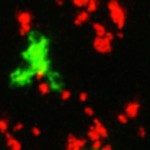Lien vers Pubmed [PMID] – 21078912
J. Immunol. 2010 Dec;185(12):7394-404
Lymphocyte arrest and spreading on ICAM-1-expressing APCs require activation of lymphocyte LFA-1 by TCR signals, but the conformational switches of this integrin during these critical processes are still elusive. Using Ab probes that distinguish between different LFA-1 conformations, we found that, unlike strong chemokine signals, potent TCR stimuli were insufficient to trigger LFA-1 extension or headpiece opening in primary human lymphocytes. Nevertheless, LFA-1 in these TCR-stimulated T cells became highly adhesive to both anchored and mobile surface-bound ICAM-1, although it failed to bind soluble ICAM-1 with measurable affinity. Rapid rearrangement of LFA-1 by immobilized ICAM-1 switched the integrin to an open headpiece conformation within numerous scattered submicron focal dots that did not readily collapse into a peripheral LFA-1 ring. Headpiece-activated LFA-1 microclusters were enriched with talin but were devoid of TCR and CD45. Notably, LFA-1 activation by TCR signals as well as subsequent T cell spreading on ICAM-1 took place independently of cytosolic Ca(2+). In contrast to LFA-1-activating chemokine signals, TCR activation of LFA-1 readily took place in the absence of external shear forces. LFA-1 activation by TCR signals also did not require internal myosin II forces but depended on intact actin cytoskeleton. Our results suggest that potent TCR signals fail to trigger LFA-1 headpiece activation unless the integrin first gets stabilized by surface-bound ICAM-1 within evenly scattered actin-dependent LFA-1 focal dots, the quantal units of TCR-stimulated T cell arrest and spreading on ICAM-1.

